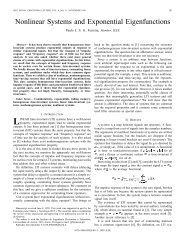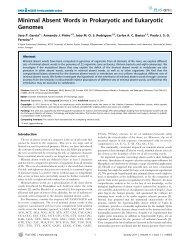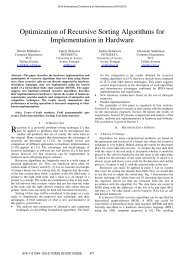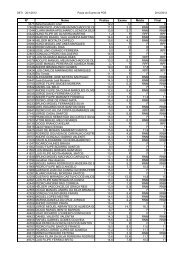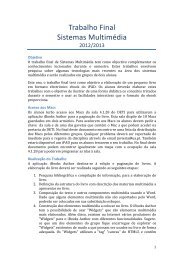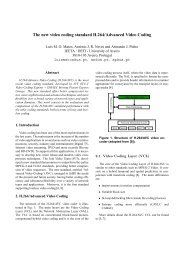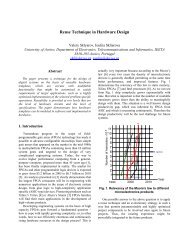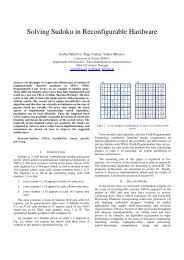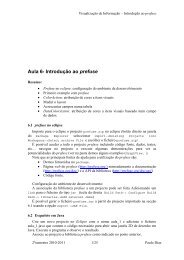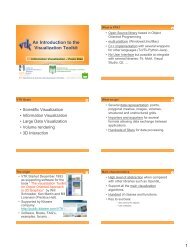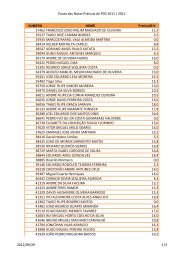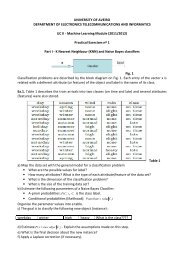Identifying obstacles in the RoboCup Middle Size League - Sweet
Identifying obstacles in the RoboCup Middle Size League - Sweet
Identifying obstacles in the RoboCup Middle Size League - Sweet
You also want an ePaper? Increase the reach of your titles
YUMPU automatically turns print PDFs into web optimized ePapers that Google loves.
<strong>Identify<strong>in</strong>g</strong> <strong>obstacles</strong> <strong>in</strong> <strong>the</strong> <strong>RoboCup</strong> <strong>Middle</strong> <strong>Size</strong> <strong>League</strong><br />
João Silva, António J. R. Neves, Nuno Lau<br />
IEETA / DETI<br />
University of Aveiro<br />
{joao.m.silva,an,nunolau}@ua.pt<br />
Abstract<br />
When build<strong>in</strong>g a representation of <strong>the</strong> environment for<br />
a robot <strong>in</strong> a multi-agent application, such as <strong>the</strong> case of<br />
robotic soccer, sensor and <strong>in</strong>formation fusion of several elements<br />
of <strong>the</strong> environment is an important task. One of <strong>the</strong><br />
aspects that should be considered is <strong>the</strong> treatment of <strong>obstacles</strong>.<br />
This paper gives an <strong>in</strong>sight of <strong>the</strong> general steps necessary<br />
for a good obstacle representation <strong>in</strong> <strong>the</strong> robot world<br />
model.<br />
Figure 1. Picture of <strong>the</strong> CAMBADA team<br />
robots.<br />
1 Introduction<br />
Nowadays, one of <strong>the</strong> most popular research doma<strong>in</strong>s <strong>in</strong><br />
<strong>the</strong> area of multi robot systems is <strong>the</strong> robotic soccer, particularly<br />
<strong>the</strong> <strong>RoboCup</strong> project 1 .<br />
Among <strong>RoboCup</strong> leagues, <strong>the</strong> <strong>Middle</strong> <strong>Size</strong> <strong>League</strong><br />
(MSL) [2] is one of <strong>the</strong> most challeng<strong>in</strong>g, us<strong>in</strong>g real nonhumanoid<br />
robot teams to play with an ord<strong>in</strong>ary soccer ball.<br />
CAMBADA, Cooperative Autonomous Mobile roBots<br />
with Advanced Distributed Architecture, is <strong>the</strong> <strong>Middle</strong> <strong>Size</strong><br />
<strong>League</strong> robotic soccer team from <strong>the</strong> University of Aveiro<br />
(Fig. 1). It is coord<strong>in</strong>ated by <strong>the</strong> IEETA 2 ATRI 3 group and<br />
<strong>in</strong>volves people work<strong>in</strong>g on several areas for build<strong>in</strong>g <strong>the</strong><br />
mechanical structure of <strong>the</strong> robot, its hardware architecture<br />
and controllers and <strong>the</strong> software development <strong>in</strong> areas such<br />
as image analysis and process<strong>in</strong>g, sensor and <strong>in</strong>formation<br />
fusion, reason<strong>in</strong>g and control.<br />
Obstacle identification on a soccer team has <strong>the</strong> advantage<br />
of provid<strong>in</strong>g coord<strong>in</strong>ation capabilities, for example, allow<strong>in</strong>g<br />
team mates to know when a given obstacle is a team<br />
mate and eventually “order” him to move away or provide<br />
cover. It is also important to ensure a global idea of <strong>the</strong> field<br />
occupancy by shar<strong>in</strong>g <strong>the</strong> knowledge of <strong>obstacles</strong> among<br />
1 http://www.robocup.org/<br />
2 Instituto de Engenharia Electrónica e Telemática de Aveiro - Aveiro’s<br />
Institute of Electronic and Telematic Eng<strong>in</strong>eer<strong>in</strong>g<br />
3 Actividade Transversal em Robótica Inteligente - Transverse Activity<br />
on Intelligent Robotics<br />
team mates. With a good cover of field <strong>obstacles</strong>, passl<strong>in</strong>es<br />
and dribbl<strong>in</strong>g corridors can be estimated more easily allow<strong>in</strong>g<br />
improvements on team strategy and coord<strong>in</strong>ation.<br />
2 Visual detection<br />
Accord<strong>in</strong>g to <strong>RoboCup</strong> rules, <strong>the</strong> robots are ma<strong>in</strong>ly<br />
black. S<strong>in</strong>ce dur<strong>in</strong>g <strong>the</strong> game robots play autonomously, all<br />
<strong>obstacles</strong> <strong>in</strong> <strong>the</strong> field are <strong>the</strong> robots <strong>the</strong>mselves (occasionally<br />
<strong>the</strong> referee, which is recommended to have black/dark<br />
pants). The vision algorithm takes advantage of this fact<br />
and detects <strong>the</strong> <strong>obstacles</strong> by evaluat<strong>in</strong>g blobs of black color<br />
<strong>in</strong>side <strong>the</strong> field of play [3]. Through <strong>the</strong> mapp<strong>in</strong>g of image<br />
positions to real metric positions [1], <strong>obstacles</strong> are identified<br />
by <strong>the</strong>ir center (triangle on <strong>the</strong> image captures) (Fig. 2 b))<br />
and left and right limits (squares on <strong>the</strong> image captures)<br />
(Fig. 2 b)). This is done by creat<strong>in</strong>g, from <strong>the</strong> center of<br />
<strong>the</strong> image (<strong>the</strong> center of <strong>the</strong> robot), radial sensors around <strong>the</strong><br />
robot, each one represent<strong>in</strong>g a l<strong>in</strong>e with a given angle, which<br />
are <strong>the</strong>n analyzed for <strong>the</strong> search of black regions. These are<br />
called scanl<strong>in</strong>es [4].<br />
S<strong>in</strong>ce <strong>the</strong> vision system is a non-SVP hyperbolic catadioptric<br />
system [1], sizes of objects on <strong>the</strong> image vary with<br />
<strong>the</strong> distance to <strong>the</strong> robot. Due to an <strong>in</strong>verse distance map<br />
calculation, by explor<strong>in</strong>g a back-propagation ray-trac<strong>in</strong>g approach<br />
and <strong>the</strong> ma<strong>the</strong>matical properties of <strong>the</strong> mirror surface,<br />
<strong>the</strong> relation of distances <strong>in</strong> <strong>the</strong> image and <strong>the</strong> real
world is estimated and <strong>the</strong> image blobs size can be mapped<br />
<strong>in</strong>to approximated real metric sizes. These estimated metric<br />
positions <strong>in</strong>clude <strong>the</strong> <strong>obstacles</strong> left and right limits and <strong>the</strong>ir<br />
centers.<br />
3 Obstacle identification<br />
With <strong>the</strong> objective of ref<strong>in</strong><strong>in</strong>g <strong>the</strong> <strong>in</strong>formation of <strong>the</strong> <strong>obstacles</strong>,<br />
and have more mean<strong>in</strong>gful and human readable <strong>in</strong>formation,<br />
a match<strong>in</strong>g is attempted, <strong>in</strong> order to try to identify<br />
<strong>obstacles</strong> as team mates or opponents.<br />
To identify which of <strong>the</strong> <strong>obstacles</strong> are team mates and<br />
which are opponent robots, a fusion between <strong>the</strong> own visual<br />
<strong>in</strong>formation of <strong>the</strong> <strong>obstacles</strong> and <strong>the</strong> shared team mates positions<br />
is performed. The agent keeps <strong>in</strong>formation about each<br />
obstacle it is detect<strong>in</strong>g, eventually with a numeric identification,<br />
correspondent to <strong>the</strong> team mate if it succeeded on its<br />
match<strong>in</strong>g. In Fig. 2 c), each robot represents itself and robot<br />
6 (<strong>the</strong> lighter gray) draws all <strong>the</strong> 5 <strong>obstacles</strong> evaluated (represented<br />
by squares with <strong>the</strong> same gray scale as itself). All<br />
<strong>the</strong> <strong>obstacles</strong> correspondent to team mates were correctly<br />
identified (marked by its correspond<strong>in</strong>g number over <strong>the</strong> obstacle<br />
square) and <strong>the</strong> opponent is also represented with no<br />
number.<br />
4 Obstacle shar<strong>in</strong>g<br />
Obstacle shar<strong>in</strong>g allows <strong>the</strong> team robots to have a more<br />
global perception of <strong>the</strong> field occupancy, allow<strong>in</strong>g <strong>the</strong>m to<br />
estimate, for <strong>in</strong>stance, pass<strong>in</strong>g and dribbl<strong>in</strong>g corridors more<br />
effectively.<br />
However, one has to keep <strong>in</strong> m<strong>in</strong>d that, ma<strong>in</strong>ly due<br />
to illum<strong>in</strong>ation conditions and eventual reflexive materials,<br />
some of <strong>the</strong> detected <strong>obstacles</strong> may not be exactly robots,<br />
but dark shadowy areas. If that is <strong>the</strong> case, <strong>the</strong> simple shar<strong>in</strong>g<br />
of <strong>obstacles</strong> would propagate any false obstacle among<br />
<strong>the</strong> team. Thus <strong>the</strong> algorithm for shar<strong>in</strong>g <strong>the</strong> <strong>obstacles</strong><br />
makes a fusion of <strong>the</strong> several team mates <strong>in</strong>formation.<br />
After build<strong>in</strong>g <strong>the</strong> worldstate us<strong>in</strong>g only <strong>in</strong>formation<br />
from its own sensors, <strong>the</strong> agent checks obstacle <strong>in</strong>formation<br />
shared by team mates. Their <strong>obstacles</strong> are matched with <strong>the</strong><br />
own ones. Each robot keeps <strong>the</strong> <strong>in</strong>formation of <strong>obstacles</strong><br />
that it does not see by itself. However, it only accepts an<br />
obstacle if it is confirmed by at least two team mates. Fig. 3<br />
depicts a situation where robot 2 considers <strong>the</strong> existence of<br />
an obstacle <strong>in</strong> <strong>the</strong> center of <strong>the</strong> field by shared <strong>in</strong>formation.<br />
It only accepted <strong>the</strong> obstacle because it was confirmed by<br />
both robots 5 and 6.<br />
Figure 3. Image of <strong>the</strong> control station.<br />
a) b)<br />
c)<br />
Figure 2. Illustration of <strong>obstacles</strong> detection<br />
and identification. In a): image acquired from<br />
<strong>the</strong> robot camera; In b): <strong>the</strong> same image after<br />
process<strong>in</strong>g; In c): image of <strong>the</strong> control station.<br />
References<br />
[1] B. Cunha, J. Azevedo, N. Lau, and L. Almeida. Obta<strong>in</strong><strong>in</strong>g <strong>the</strong><br />
<strong>in</strong>verse distance map from a non-SVP hyperbolic catadioptric<br />
robotic vision system. In U. Visser, F. Ribeiro, T. Ohashi, and<br />
F. Dellaert, editors, <strong>RoboCup</strong> 2007: Robot Soccer World Cup<br />
XI, volume 5001 of LNAI, pages 417–424. Spr<strong>in</strong>ger, 2008.<br />
[2] MSL Technical Committee 1997-2009. <strong>Middle</strong> <strong>Size</strong> Robot<br />
<strong>League</strong> Rules and Regulations for 2009, 2008.<br />
[3] A. Neves, G. Corrente, and A. P<strong>in</strong>ho. An omnidirectional vision<br />
system for soccer robots. In J. Neves, M. F. Santos, and<br />
J. M. Machado, editors, Progress <strong>in</strong> Artificial Intelligence,<br />
volume 4874 of LNAI, pages 499–507. Spr<strong>in</strong>ger, 2007.<br />
[4] A. Neves, D. Mart<strong>in</strong>s, and A. P<strong>in</strong>ho. A hybrid vision system<br />
for soccer robots us<strong>in</strong>g radial search l<strong>in</strong>es. In Proc. of <strong>the</strong> 8th<br />
Conference on Autonomous Robot Systems and Competitions,<br />
Portuguese Robotics Open - ROBOTICA’2008, pages 51–55,<br />
Aveiro, Portugal, April 2008.



